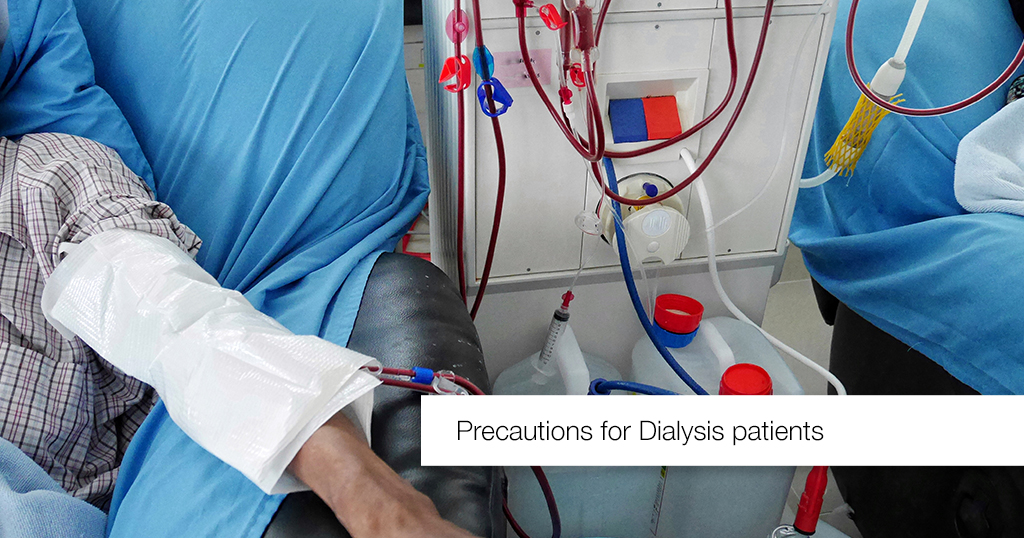Dialysis takes over the function of the kidney and numerous people with kidney disease are benefited by it. However, it does not cure your kidney disease. For certain patients with acute kidney failure, dialysis can be a treatment for just a short time, till the kidney starts functioning normally. However, in case of chronic or end-stage kidney failure, dialysis is required for rest of your life till you get kidney transplantation done.
Why is dialysis required?
When your kidney fails and is unable to take care of your body requirements, dialysis is required. Dialysis performs the following functions:
- Removes waste, salt and extra fluid from your body, therefore prevents its accumulation in your body.
- Ensures appropriate level of certain electrolytes like sodium, potassium etc. are maintained.
- Helps in controlling blood pressure.
What are the risks associated with dialysis?
While dialysis can save your life, we must be aware of the precautions and risks involved.
- Risks associated with hemodialysis are:
- Low blood pressure
- Anemia
- High potassium level in blood
- Irregular heart beat
- Inflammation of the membrane around the heart (pericarditis)
- Sepsis
- Muscle cramps
- Itching
- Bloodstream infection
- Risks associated with peritoneal dialysis are:
- Peritonitis, an infection of the membrane lining the abdominal wall
- Weakening of abdominal muscles
- High blood sugar level
- Hernia
- Fever
- Weight gain
- Muscle cramps
- Itching
- Bloodstream infection
- Risks associated with Continuous Renal Replacement Therapy (CRRT) are:
- Infection
- Low blood pressure
- Weakening of bones
- Hypothermia, body temperature drops below 95°F
- Disturbance in electrolytes (e.g. calcium, potassium etc.)
- Anaphylaxis, severe allergic reaction to allergens
- Other risks involved in long-term dialysis are:
- Amyloidosis, accumulation of abnormal protein in your body which can further lead to organ failure. Organs which are usually affected are heart, liver, kidney etc.
- Depression
How can you avoid infection?
Dialysis patients are more prone to infection which can have a direct impact on health. Infection occurs when bacteria, fungi or virus enter your body by touch or when you inhale the infecting agent through nose or mouth. Dialysis patients sometimes get infected due to vulnerability of their access site or other co-existing health conditions (e.g. diabetes). You can take simple measures to avoid such infections:
- Practice hand hygiene: This can be done by frequent washing your hand and using alcohol based hand sanitizer. Ask your doctor the steps for proper hand wash.
- Take care for your access site: For Hemodialysis, to prevent pressure on your access site, wear loose cloth or jewellery. Also, use your other hand to carry objects, so that you don’t strain your access area. For Peritoneal dialysis, keep your catheter close to your body, and avoid clothing that is tight. When not in use, you should cap the catheter and clamp the transfer set.
- Get vaccinated as and when recommended by the doctor.
What precautions should be taken to prevent peritonitis?
If you are undergoing peritoneal dialysis, the chances of getting infection of the peritoneum are more. Peritonitis can be easily treated if found early and you are the one who can best prevent it. Listed below are the precautions you can undertake:
-
- Keep your catheter and exit site clean and dry.
- If possible, shower daily after your access site gets healed.
- Avoid swimming or tub baths, till further instruction from your doctor.
- Keep Strict adherence to hand washing steps.
- Take care of your access site, as per the instruction given by your doctor.
- Use a new mask as you take care of your access site.
- Keep the end of the catheter capped and clamped, when not in use.
Daily inspect the catheter tunnel and exit site for any redness, drainage, tenderness or swelling.
Conclusion
Patients who undergo dialysis treatment are more prone to getting an infection. Both hemodialysis and peritoneal dialysis have side effects, due to the way dialysis is carried out and also because it can compensate only partially for the loss of kidney function. You are the most important member of your care team as you are aware of your body i.e. what is normal and what is abnormal. Precautions have to be taken during and after dialysis. Diet for dialysis patient and lifestyle have to be changed accordingly. You should closely monitor how your body is reacting and keep the doctor well informed about such details. Any infection or side-effects if not handled on time, can be life-threatening.


















